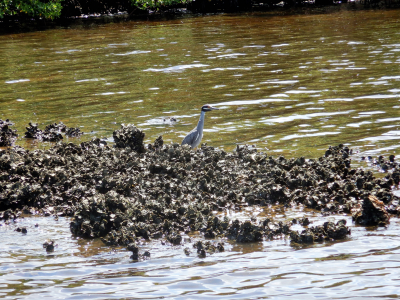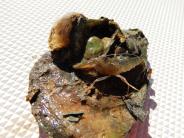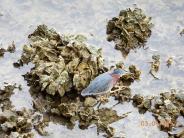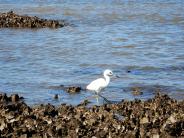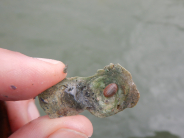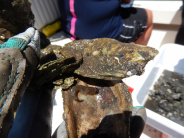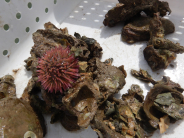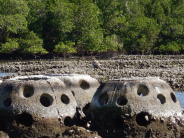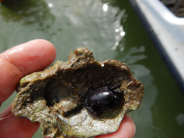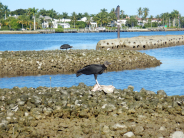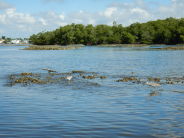Oysters and their reef ecosystem
Oysters are known as ecosystem engineers because of their formation of three-dimensional reef structures. The oyster reef structures support over 300 species of organisms such as fishes, crabs, and birds that depend directly or indirectly on the reefs for habitat, nursery, and as a food source. Many organisms found on oyster reefs have no commercial value but serve as food sources for other commercial and recreational fishes. Oysters feed by filtering and eating particles in the water column. One single oyster is capable of filtering up to 50 gallons of water in 24 hours! Oysters filter nutrients, phytoplankton, sediments, heavy metals, and toxins out of the water column. This filtering improves water quality and clarity as well as increases the penetration of light into the water column which enables the growth of submerge aquatic vegetation (e.g. seagrass). Additionally, oyster reefs act to stabilize shorelines and to defend coastlines from erosion by absorbing wave energy and boat wakes.
Eastern oyster (Crassostrea virginica)
Eastern oysters (Crassostrea virginica) are found throughout coastal waters of the Atlantic Ocean and Gulf of Mexico, with a habitat range extending from Canada to Mexico. Oyster spawning in Florida generally takes place from late spring through the fall with environmental cues such as increases in water temperatures and salinities initiating oysters to release their eggs and sperm into the water column. The fertilized eggs then develop into larvae over the course of two to three weeks. During that time, larvae will grow a foot-like appendage which they use to find suitable substrate to attach to. Larvae generally attach to other oyster shell thus creating oyster reefs; however, oysters can attach to any hard substrate such as mangrove prop roots, docks, or seawalls. Upon finding a suitable substrate, larvae secrete a glue which allows for the permanent attachment to the substrate. The attached larvae are then referred to as “spat”. Interestingly, most oysters begin their lives as males and then transform into females later in life.
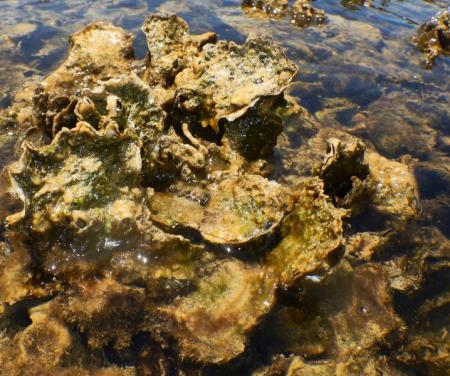
Oysters become juveniles at one year of age and are capable of spawning within their first year of life. Oysters typically grow up to 25 mm (1 in) per year, however the amount of growth is dependent on various environmental and biological factors: water temperature, food availability, salinity, disease, among others. For example, oysters will grow faster in higher salinities as opposed to lower salinities with 14-28 ppt being the ideal salinity range for growth and development. Oysters can tolerate periods of low salinity (<10 ppt) by closing their shells and ceasing to filter feed until conditions return to more favorable salinities. At higher salinities (>30 ppt) predation and disease becomes more prevalent, resulting in greater oyster mortality. Oysters need water with dissolved oxygen levels of at least 3.2 milligrams per liter (mg/l), but 5.5 mg/l or more is best for survival and growth.
Eastern oysters grow up to 10 cm in length and have been found to live to be 20 years old.
An oyster reef is formed over time as oysters continually settle, reproduce, and grow on top of existing oysters and/or oyster shell. The continual settlement creates the complex structures known as oyster reefs. Oyster reefs can be either subtidal (always covered by water) or intertidal (exposed during low tide), because oysters are tolerant of desiccation (drying out) for several hours. Finally, because oysters are sessile (fixed in place; immobile), benthic organisms, which can bioaccumulate toxins and pollutants through their filtration, are commonly used as indicators to assess environmental conditions.
The SW Florida Oyster Reef Ecosystem
- Oyster shell and reefs serve as spawning substrate for: skilletfish, Florida blenny, feather blenny, frillfin goby
- Organisms feeding directly on oysters: mud crab, black drum, crown conch, shorebirds/wading birds
- Decapod organisms found on oyster reefs: bigclaw snapping shrimp, marsh grass shrimp, penaeid shrimp, blue crab, stone crab, flatback mud crab, longnose spider crab, Florida stone crab, mud crab, green porcelain crab, iridescent swimming crab
- Fishes found on or near reefs: fringed pipefish, sheepshead, sheepshead minnow, silver perch, Florida blenny, mojarra, skilletfish, naked goby, code goby, frillfin goby, crested goby, white grunt, feather blenny, highfin blenny, pinfish, gray snapper, lane snapper, gulf toadfish, blackcheek tonguefish, drum
- Recreationally or commercially important fishes associated with oyster reefs: Atlantic menhaden, tautog, striped bass, Spanish mackerel
- Other organisms associated with oyster reefs: gastropod mollusks, polychaete worms, boring sponges, waterbirds (e.g. American oystercatcher), barnacles

